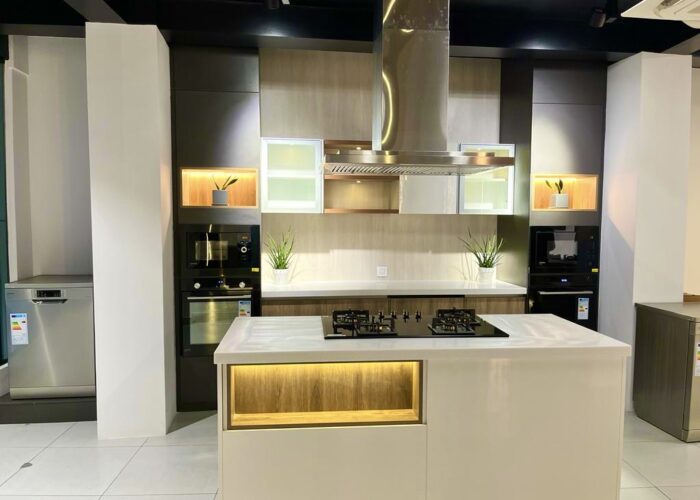After establishing a network of 50-plus exclusive branded outlets (EBOs), Crompton is shifting focus towards multi-brand outlets (MBOs) for its built-in kitchen appliances. The company had launched built-in appliances in early 2022 to address the Rs 2,200-crore market. As Crompton’s built-in network grows, the company aims to empower kitchen sellers with knowledge and consumer insights.
“The response to our offering has been phenomenal. While we had a target of establishing 30 exclusive outlets in the first year of launch, we have already touched the 50 number. The interest from channel partners has been very encouraging. Several partners have indicated that they would like to set up a second store,” says Nitesh Mathur, Crompton’s vice president for new business.
Mathur attributes the success of the Crompton exclusive studio model to the company’s unconventional approach. “Our stores are designed to provide an uncluttered display and the feel of an upscale lounge. The appliances are displayed in a manner that encourages conversation about their technology and performance and the kitchen design. For the designer and the customer, the outlet is an experiential space.”
The Crompton EBO focusses on the five key categories of built-ins – chimney, hob, microwave, oven, and dishwasher – with models addressing three market segments according to price.
“Our business model is disruptive. It is designed to deliver an attractive RoI to the channel partners, so that they can then focus on sales rather than blocking funds in inventory. Additionally, we support them with a 360-degree marketing program to ensure the desired sell out. As a result, most of our EBOs are turning profitable within 12 months of starting operations.”
Mathur says that in the next phase of network expansion, the brand will be visible in the white goods channel through the shop-in-shop model. “We are setting up exclusive shop-in-shops at MBOs and with kitchen dealers. This will provide the brand higher visibility within the traditional white goods and home improvement channel. Much to our surprise, many dealers have offered to create exclusive spaces for Crompton in their outlets.”
As a legacy brand, Crompton’s approach has been to build the market ground-up for the categories it is present in. For built-in appliances too it is doing the same, by first identifying the unmet needs of the consumer, and then developing products that would “make the customer’s life comfortable, not expensive,” as Mathur puts it.
Last year, at the time of the launch, Mathur had said that Crompton’s entry into built-in appliances will be disruptive. He cited several innovations in design and technology to justify his statement. These include a shift to energy-saving and extra powerful invertor motors in chimneys; redesign of the internal structure of the chimney to bring down noise levels; and addition of smart features like gesture control for chimney motor speed, auto-on for chimney, intelligent auto-clean for chimney filter, and timer control and flame failure device for the hob.
There are two critical insights that the Crompton team has gained from the extensive interactions it has had with stakeholders. First, design professionals are foremost concerned about sustainability and efficiency while recommending an appliance. They assess the product on parameters of dependability (service, support, availability), technology and performance, and CMF (colour, material, form), in that order.
“These insights were obtained through interactions that we had in small groups with architects and designers in various cities. But the best part was that the learning was two-way. They learnt a lot about considerations for new product development and the technology that goes into them, while we learnt of the pain areas of the specifiers. In fact, we unlearnt a lot before we could learn,” Mathur quips.
Second, the modular kitchen channel will play a big role in the success of the appliance industry. Also, that kitchen channel partner will have to evolve and work closely with the designer and appliance brand to fully satisfy the customer.
ALSO READ: How Prolance is Mending the Link between Design and Manufacture
Crompton’s research revealed that while the kitchen customer was looking for a complete solution, the channel partner, appliance vendor and designer were operating in silos. “We found that the kitchen sellers were more focused on matters related to design. Discussions about the selection, installation and operation of the appliances were left for the tail end of the transaction. There was insufficient evaluation of the appliance’s suitability, practicality, and performance. This leads me to believe that there is a clear opportunity to enhance the consumer experience of buying and ownership of kitchens.”
Mathur believes this is what’s leading to the sub-optimum penetration of the built-in category, and underperformance of the kitchen channel because of missed revenue potential. He wants to work with kitchen brands to transform their business.
“We strongly feel that a hybrid model of kitchen retail needs to emerge. Besides displaying kitchens the retailer must allocate exclusive space for appliances so that customers can make informed choices. In this way, the selling process will become knowledge-based. There will be more discussions about energy, water and air. Ultimately this will bring more footfalls and revenue to the outlet. The dealership will benefit from the share of voice that appliance brands build for themselves in the market.”

According to Mathur, kitchen appliances make up for about 25 per cent and more of the average kitchen ticket value. “In the premium and luxury segments, this proportion can be more than 50 per cent.”
During the lockdowns, when consumers had to spend considerable time indoors, there was heightened awareness about quality of living. The kitchen and home improvement industry got a major boost due to newfound concern for safety, hygiene and healthy living. Overnight the dishwasher in particular became a sought-after product, often in short supply. The time of the kitchen appliance had arrived.
The Covid period also led to a proliferation of direct-to-customer (D2C) brands in the home improvement space. Tech-driven enterprises like Livspace, Homelane, Bonito Design and MyHome by Saint-Gobain have democratised interior design. This has resulted in the kitchen becoming affordable and more accessible to the masses.
On the other hand, the march of the kitchen specialist continues. Arancia (52), Wurfel (40), Saviesa (35), Spacewood (31), Panasonic (25), Nobilia (8), Ultrafresh (125) – these are examples of how the number of branded outlets has grown in the last 2-3 years.
ALSO READ: Digitalisation will Drive Furniture Production
The recent spate of consolidations within the kitchen appliances sector is a further indication of how this industry is being viewed.
In 2021 Whirpool of India raised its equity in built-in appliances maker Elica PB to 87.25 per cent, by acquiring an additional 38.25 per cent for Rs 428 crore. In the same year, the Rs 2,722 crore small appliances maker Prestige Group paid Rs 30 crore for a 40.81 per cent stake in kitchen specialist Ultrafresh. Prestige will eventually increase its stake to 51 per cent. The Rs 5,500-crore Crompton itself acquired an 81 per cent stake in small kitchen appliance and cooking equipment manufacturer Butterfly Gandhimati in 2022, for a consideration of Rs 2,076 crore.
The role of appliances in shaping the kitchen industry cannot be understated. In fact kitchens and appliances are twins joined at the hip. Crompton’s collaborative approach could lead to the emergence of new leaders.



